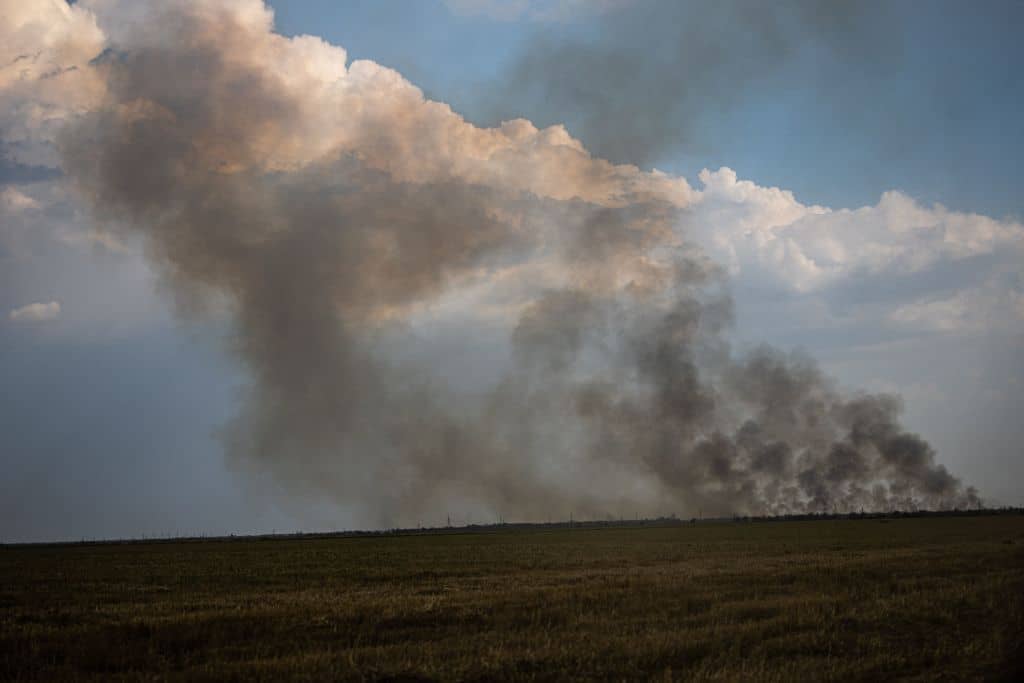The Ukrainian armed forces launched a long–awaited offensive on Kherson this week. However, the counter-offensive was signalled for so long by both Ukrainian and western sources that the Russian army had plenty of time to significantly reinforce its positions there, meaning that the Kherson front is now more heavily manned by Russian troops than most other stretches of the frontline.
Ukrainian government sources have requested a total blackout of media reports from the frontlines so exact details are sparse. But what is clear is that the Russian movement of forces has already had two positive effects for Ukraine, even before the actual counter-offensive operation was launched.
The first has been to further reduce the Russian army’s capacity to conduct large-scale offensive operations against Ukrainian positions in the Donbas by diverting already depleted and overstretched units, artillery and other things like electronic warfare equipment and air defences down south to defend Kherson. In other words, signalling a southern counter-offensive has forced the Russian army’s limited mobile reserve forces to be deployed to a largely defensive position ahead of the Ukrainian offensive. This has handed Ukraine the initiative for arguably the first time since the invasion began in February, although tactical-level Russian offensive activity continues in the Avdiivka and Bakhmut areas of the southern Donbas with some local success.
To avoid heavy urban fighting, Ukrainian forces are likely to try and break through the Russian defences north of the city itself
The second success of the Ukrainian strategy is that in addition to reducing offensive pressure in the Donbas by forcing the Russian army to redeploy key forces south, many of the Russian units now in Kherson have had their offensive capabilities reduced – and are now potentially more vulnerable than anywhere else on the frontlines. This is because the key Russian-occupied city of Kherson and its surrounding area are on the western bank of the Dnipro river, on the same side as the Ukrainian army.

As such, Kherson is only accessible from Crimea and the rest of the Russian army in Ukraine via a few key bridges across the river. To take advantage of this, Ukraine has repeatedly used US-supplied HIMARS rocket artillery systems to strike the Antonivskyi Bridge in Kherson itself and the crossing points at the Nova Kakovkha dam to the north of the Oblast. This has forced the Russian army to rely on ferries and temporary pontoon bridges, which themselves have been repeatedly targeted and hit with HIMARS strikes. A campaign of sabotage attacks has also been mounted by Ukrainian special forces and partisan units against key railhead depots and airbases deep in Russian-occupied Crimea. This strategy has succeeded in seriously limiting the supplies of food, medicine, heavy equipment and artillery ammunition available to the Russian units defending the Kherson front. The destruction of the bridges also means that Russian troops defending Kherson know that they have very limited potential escape routes if Ukrainian forces do achieve a major breakthrough.
Now that the counter-offensive itself has been officially launched, the key battleground may well be to the north of Kherson towards Nova Kakovkha. Ukrainian commanders would undoubtedly prefer to avoid having to fight their way into the city of Kherson itself. Urban assaults almost always result disproportionately heavy casualties for attacking forces and usually cause heavy destruction in the town or city in question. Russia discovered this in Mariupol, which took months to subdue in the face of heroic, but completely outnumbered and severely under-equipped defenders, and was reduced to rubble in the process. To avoid heavy urban fighting, Ukrainian forces are likely to try and break through the Russian defences north of the city itself, while keeping pressure on its outer defence lines to fix Russian forces there in position. Ultimately, the Ukrainian strategic goal is probably to advance to and then find a way to cross the Dnipro in strength to the north of Kherson itself.
This would be disastrous for Russia, since it has massed between 20 and 30 battalion tactical groups worth of forces in and around Kherson, which could then be trapped with no easy way to retreat or resupply. A Russian retreat without much of their heavy equipment would still potentially be possible since Ukraine is short of large-scale heavily mechanised units and the logistics to facilitate a rapid advance over long distances following a major breakthrough. But the Russian army would sustain serious losses from artillery attacks and ambushes during any retreat in open terrain. Furthermore, the Russian army does not have significant usable reserve forces left to commit to its invasion, and the recapture or loss of Kherson would be a huge symbolic defeat for President Putin.
For now this remains a likely medium-term Ukrainian ambition rather than an immediate possibility. The terrain around Kherson is largely open fields with limited cover or concealment from UAVs, artillery and anti-tank guided missiles. As such, Ukrainian commanders will need to be cautious to avoid risking very heavy casualties that might squander the initiative that they have fought so hard to wrestle from the invading forces. The coming days and weeks will probably see Ukrainian forces grinding down Russian positions with accurate artillery fire, probing for weaknesses with small units, while continuing to strike Russian supply line bottlenecks and command posts across the Dnipro with HIMARS and special forces.
The Ukrainian army has proven itself to be highly capable, innovative and immensely brave at the tactical unit level, especially on the defensive. But it has few units trained to effectively fight in large brigade-size formations suitable for offensive manoeuvre warfare at scale. Therefore, the current counter-offensive may be a cautious process that seeks to take ground in a series of small advances before the winter weather largely shuts down movement for both sides, while inflicting heavy casualties that Russia cannot easily replace. Meanwhile, there is always a chance that Russian morale may fail and lead to a rout at a key section of the lines. If that happens, Ukraine could advance rapidly towards the Dnipro and possibly even cross it to threaten Russian forces still in Kherson with encirclement.






Comments